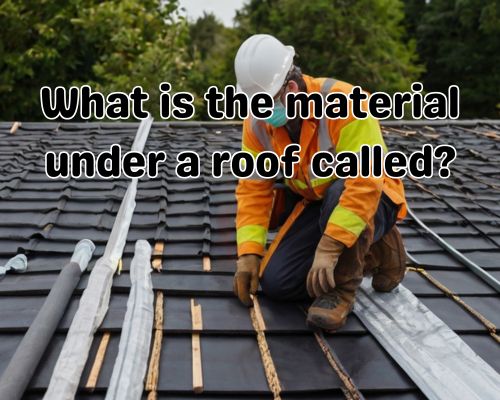When it comes to home construction or renovation in West Palm Beach, Florida, understanding the components of your roof isn’t just helpful—it’s essential. Whether you’re dealing with hurricane season, planning a home upgrade, or filing an insurance claim, knowing what the material under a roof is called can give you a surprising edge. Spoiler alert: it’s not just shingles doing the heavy lifting.

With Star Roofing, let’s explore roofing underlayment, the unsung hero that protects thousands of homes from the Florida elements.
The Material Beneath Your Roof: It’s Called Underlayment
The material under a roof is typically referred to as roofing underlayment. Positioned between the roof decking and the outer roofing material—like asphalt shingles, metal panels, or clay tiles—underlayment acts as a crucial moisture barrier and secondary defense against water infiltration.
In West Palm Beach, where intense sun, high humidity, and seasonal storms are the norm, underlayment plays an even more vital role in safeguarding your roof’s integrity.
Types of Roofing Underlayment Used in West Palm Beach, FL
The most common types of underlayment found in South Florida roofing systems include:
1. Asphalt-Saturated Felt
Often referred to as felt paper or tar paper, this traditional underlayment is made from organic or fiberglass substrate saturated with asphalt. While it’s affordable and widely available, it’s not always the best choice for humid or storm-prone areas like West Palm Beach due to its limited water resistance and vulnerability to UV exposure.
2. Synthetic Underlayment
Now considered the gold standard in modern roofing, synthetic underlayment is made from polypropylene or polyethylene polymers. It’s lightweight, tear-resistant, and offers excellent moisture protection—ideal for withstanding tropical downpours and high winds.
Roofing companies in West Palm Beach often favor synthetic options because they resist mold growth, lay flat, and hold up well in Florida’s extreme weather conditions.
3. Rubberized Asphalt Underlayment (Peel-and-Stick)
This premium underlayment has a self-adhering back and offers superior waterproofing. It’s often used in areas most vulnerable to leaks, such as valleys, eaves, and around roof penetrations (like chimneys and vents). In West Palm Beach homes, peel-and-stick underlayment is especially useful for low-slope roofs or in areas prone to wind-driven rain.
Why Underlayment Matters in West Palm Beach
Let’s break down a few real-world reasons why understanding and investing in high-quality roofing underlayment matters in Palm Beach County:
🌀 1. Storm Resilience
From tropical storms to full-blown hurricanes, West Palm Beach homes take a beating every year. Even if your top layer of shingles is compromised, a solid underlayment can help prevent water from leaking into your attic or insulation.
🌞 2. UV and Heat Protection
Florida roofs are exposed to relentless sunlight. Quality underlayment reflects some of that heat, helping to improve energy efficiency and reduce cooling costs—a big bonus in the sweltering West Palm Beach summers.
🦠 3. Mold and Mildew Defense
Moisture trapped beneath the roof surface is a breeding ground for mold. Synthetic underlayments typically resist water absorption and can help keep your attic environment dry and healthy.
What Materials Go Below the Underlayment?
While the underlayment sits beneath your roof covering, it’s also layered above other critical materials:
- Roof Decking: Usually made from plywood or OSB (Oriented Strand Board), this is the structural base onto which all other roofing components are attached.
- Roof Trusses or Rafters: The wooden framework that supports the decking.
- Insulation and Vapor Barriers: Located further inside the roofing system to regulate temperature and moisture.
Understanding this layering is especially important when assessing roof repair costs in West Palm Beach. Contractors often base their pricing on how many layers need replacing.
Local Codes and Roofing Standards in West Palm Beach
In Florida—especially in Palm Beach County—building codes are strict. The Florida Building Code (FBC) outlines specific underlayment requirements for wind uplift resistance, moisture protection, and installation techniques. Local roofing contractors in West Palm Beach are well-versed in these codes, which are designed to mitigate hurricane damage and prolong roof lifespans.
If you’re replacing a roof or buying a home in the area, make sure your roofer is licensed and insured and follows FBC regulations for underlayment.
How to Tell If Your Underlayment Needs Replacing
Your underlayment may need replacing if:
- You notice leaks in the attic or ceiling after rain.
- Roof shingles appear buckled or lifted.
- You see black paper or synthetic fabric curling up around the roof edges.
- A home inspection reveals water-damaged decking beneath your roof.
In most cases, the underlayment is replaced during a full roof replacement, which typically occurs every 15 to 30 years, depending on the type of roof covering and the intensity of local weather.
Local Roofing Experts in West Palm Beach
If you suspect underlayment issues or are simply planning for a future roof replacement, reach out to licensed roofing companies in West Palm Beach. Some well-reviewed options include:
- Aastro Roofing Company, Inc.
- RoofClaim.com
- Code Red Roofers, Inc.
These firms are familiar with local regulations and offer products tailored to the South Florida climate—especially synthetic underlayments rated for high heat and storm conditions.
Final Thoughts: It’s What’s Underneath That Counts
So, what is the material under a roof called? Now you know—it’s the underlayment, a quiet but powerful layer of protection that keeps your home dry, your energy bills lower, and your structure safer.
In a climate like West Palm Beach, Florida, where torrential rains and high winds are par for the course, underlayment isn’t just a part of your roof—it’s a key part of your peace of mind. If your roof is due for an inspection, don’t just look at the surface. Ask about the underlayment. It could be the difference between a weatherproof home and an emergency repair.